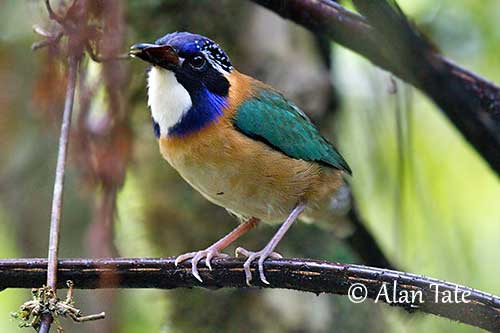
Fr: Brachyptérolle pittoïde
Ang: Pitta-like Ground-Roller
All: Blaukopf-Erdracke
Esp: Carraca terrestre cabeciazul
Ita: Coracia terragnola pitta
Nd: Blauwkopgrondscharrelaar
Sd: blåpannad markblåkråka
Mal: Fangadiovy, harakaraka, Sakoka, Tsakoka
Photographers:
Jean Michel Fenerole
Photos d’Oiseaux du monde
William Price
PBase-tereksandpiper & Flickr William Price
Dubi Shapiro
Dubi Shapiro Photo Galleries & Dubi Shapiro's Pictures on IBC
Alan & Ann Tate
AA Bird Photography
Text by Nicole Bouglouan
Sources:
HANDBOOK OF THE BIRDS OF THE WORLD Vol 6 by Josep del Hoyo-Andrew Elliott-Jordi Sargatal - Lynx Edicions, 2001 - ISBN: 848733430X
Wildlife of Madagascar par Ken Behrens, Keith Barnes - ISBN: 140088067X, 9781400880676 – Editeur: Princeton University Press, 2016
The Birds of Africa: Volume VIII: The Malagasy Region: Madagascar, Seychelles, Comoros, Mascarenes - Par Roger Safford, Frank Hawkins – ISBN: 1408190494, 9781408190494- Editeur: A&C Black, 2013
Birds of the Indian Ocean Islands Par Ian Sinclair, Olivier Langrand - ISBN: 1868729567, 9781868729562- Editeur: Struik, 2003
Creagus - GROUND-ROLLERS Brachypteraciidae
Pitta-like Ground-Roller
Atelornis pittoides
Coraciiformes Order – Brachypteraciidae Family
INTRODUCTION:
The Pitta-like Ground-Roller is endemic to Madagascar where it frequents the humid evergreen forest in the east of the island, from sea-level up to 2,000 metres of elevation.
This bright-coloured bird is shy and elusive, and often seen alone walking on the ground and searching for prey. It is easily located by its call.
This species is relatively common in its range, but it is threatened by destruction and fragmentation of the forest for agriculture expansion. However, the population is currently stable.
DESCRIPTION OF THE BIRD:
Biometrics:
Length: 25-29 cm
Weight: M: 83-90 g – F: 87-108 g
The Pitta-like Ground-Roller adult has bronzy green upperparts, except the rufous hind collar, the dark brown primaries and the blue outer rectrices. The upperwings often appear mostly green.
On the underparts, flanks are rufous-orange, but the remaining underparts are white. On the underwings, the dark grey flight-feathers are crossed by broad, white band.

The head is cobalt-blue with narrow, white supercilium and broad, black band across the eye forming a black mask. We can see some white-dotted black feathers above the rear of the white supercilium. On forecrown and central hind crown, the feathers are narrowly edged brown with sparse white dots.
Chin and throat are white, forming a conspicuous white bib bordered with blue. The blue colour forms a narrow blue breast band extending to head sides and bill base, and emphasizes the black mask.
The bill is blackish. The eyes are dark brown. Legs and feet are pale pinkish-grey.
Male and female are similar.
The juvenile is duller than adults. It has dark speckles on throat. The blue head shows some brownish-buff markings. The eye stripe is buff (not black) with darker spots. The white markings of the adults are buffish in juvenile. The bill has pinkish lower mandible.
RANGE:
The Pitta-like Ground-Roller is commonly found in the east of the island, from extreme N to far S, also in NW and on central High Plateau.

HABITAT:
The Pitta-like Ground-Roller is found in different forest types from sea-level up to 2,000 metres of elevation, but it is mostly common between 800 and 1,600 metres. It usually frequents undisturbed rainforest with thick leaf litter, dense herb layer and dead wood. It may occur in drier forest and secondary growths, and locally in heavily degraded secondary forest.
CALLS AND SONGS: SOUNDS BY XENO-CANTO
The Pitta-like Ground-Roller produces a muffled, slightly barking “boop” during the breeding season. This is a quiet, penetrating sound, repeated at intervals of 3-10 seconds. Individuals usually respond to each other.
The alarm call is a brief “trrrt” and it gives a short “howk” when flushed.
It ascends to the mid-storey of the forest for calling, usually between 1 and 10 metres above the ground.
BEHAVIOUR IN THE WILD:
The Pitta-like Ground-Roller feeds on a variety of invertebrates, mostly insects such as ants, beetles, butterflies and cockroaches, and also worms. It also takes small vertebrates such as chameleons and frogs.

It is very terrestrial and forages almost exclusively on the ground by walking, dashing and jumping to catch prey. It may sometimes stand motionless, then making short runs in order to catch a prey in quick sally or jump. It often wags its long tail. It is also active at dusk and probably feeds at night too.
During the breeding season, the Pitta-like Ground-Roller is territorial and probably monogamous. It nests in excavated burrow in sloping earth bank. The incubating female is occasionally fed by the male, and both parents feed the young.

REPRODUCTION OF THIS SPECIES:
The breeding season occurs between October and February, but mostly in December.
The Pitta-like Ground-Roller excavates a burrow in sloping earth bank, ending in spherical nest chamber, usually lined with dead leaves. The burrow is excavated in clear area allowing good visibility against predators.
The female lays 2-4 white eggs and incubates alone while the male occasionally feeds her. The young are fed by both parents. Incubation and fledging periods are unknown.
PROTECTION / THREATS / STATUS:
The Pitta-like Ground-Roller has relatively stable population and fairly large range. The species occurs in several protected areas, but it has rather patchy distribution.
It is threatened by degradation and destruction of its habitat for agriculture expansion and suffers hunting pressure. The breeding success may be affected by ecotourism.
However, this species breeds successfully in captivity since 2006.
The Pitta-like Ground-Roller is currently evaluated as Least Concern.

The courtship displays are unknown. These birds give regularly territorial calls while bobbing the head downwards and flicking the tail upwards. We can suggest that the bright-coloured head pattern is enhanced during the displays.
The Pitta-like Ground-Roller is sedentary, but some movements may occur according to weather conditions.
Like other ground-rollers, it has short wings and is not able to make long, sustained flight. It usually flies only short distances.
